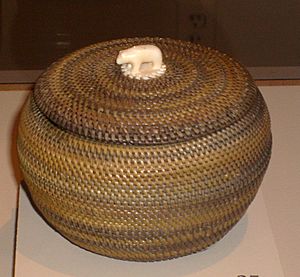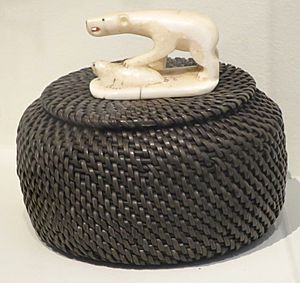Baleen basketry facts for kids
Baleen basketry is a unique type of basketry made by the Iñupiaq in northern Alaska. These special baskets are created from baleen, which is a flexible material found in the mouths of large baleen whales. This art form started in towns like Barrow, Point Hope, and Wainwright in the early 1900s.
What is Baleen Basketry?
Baleen baskets are beautiful and strong. They are made from thin strips of baleen, which is a bit like fingernails or hair. Whales use baleen plates to filter tiny food from the ocean. For baskets, artists cut this material into long, narrow strips.
How are Baleen Baskets Made?
Making a baleen basket is a careful process.
- First, thin strips of baleen are cut.
- Then, these strips are attached to small, round pieces of ivory. These ivory pieces are often at the center of the basket's bottom and lid.
- Artists use a special "coiling" method to sew the baleen strips together, layer by layer. This builds up the sides of the basket.
- Finally, a beautifully carved finial (a decorative knob or handle) is added to the lid. These finials are often made from ivory and can be very detailed. Some of the best finials are carved by Siberian Yupik artists from St. Lawrence Island and Iñupiaq artists from King Island.
Most baleen baskets are made by men, often to sell to visitors. However, since the 1970s, more women have also become involved in this amazing art. Over time, different artists have developed their own unique styles.
The Story of Baleen Basketry
Baleen basketry is a fairly new art form in North America. It began in Barrow, Alaska, after the end of large-scale commercial whaling. While the exact date is not certain, it is believed that the first baleen baskets were made between 1914 and 1918. This was after the big whaling ships stopped coming to the area.
The first known baleen basket maker was a man named Kinguktuk (also spelled Kiŋaqtaq). He lived from 1871 to 1941. Kinguktuk started making these baskets in Barrow around 1914 to 1918. For a while, he might have been the only person making them. His early baskets were similar to older baskets made from willow roots. They already had the special ivory disks at the start of the lid and base.
Today, many baleen basket makers live in Point Hope, Alaska. They continue this unique tradition, creating stunning works of art from a material that connects them to the ocean and their heritage.



